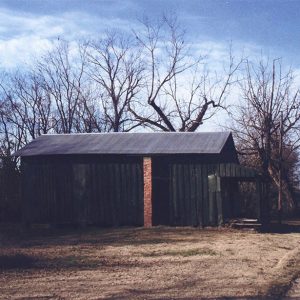calsfoundation@cals.org
Maberry (Woodruff County)
The town of Maberry in Woodruff County was founded around 1842 by early settlers George and Elizabeth Maberry and by Richard and Rachel Jones, who settled in the area before surveys were completed and bought land when land sales began. The town, located six miles west of Cotton Plant (Woodruff County), stood along the banks of the Cache River in a grove of century-old walnut and oak trees and was the center of many social events.
George Maberry established a boat landing and conducted a trade up and down the river. The town began to grow rapidly soon after it was founded. It had a post office, sawmill, cotton gin, and a still. It also had a furnishing store, planning mill, and an undertaking establishment. Maberry served as a shipping point by boat for a large timber and cotton business, and the Maberry family operated a ferryboat that crossed the Cache River. The townspeople grew cotton and raised cattle, sheep, and hogs.
George and Elizabeth Maberry had seventeen children who died during childbirth or during their youth. Only one son, Albert Freeman “Free” Maberry, survived to adulthood. When his parents died, Free took control of the family businesses of growing cotton and raising cattle, sheep, and hogs. Free Maberry also owned and operated several steamboats, The George Maberry, The Gladys Maberry, Black Diamond, White Swan, the Olympia, and the Iolanthe. He sailed the boats on the Cache River from Maberry to Brassfield (Prairie County) and to Devalls Bluff (Prairie County) on the White River, shipping crops, furniture, and goods. He was also a lawyer and owned and operated his own practice.
Free Maberry continued to build the river town by encouraging others to open businesses, creating jobs with his shipping ports, and employing workers to farm his cotton fields. In the late nineteenth century, Fort Maberry Mills operated in the town, specializing in hardwood lumber for sashes, doors, and other building material.
With the building of good roads and the coming of automobiles, there was little use for steamboats, and the town of Maberry soon began to decline. In 1905, Free Maberry erected a large stone building in Cotton Plant and opened a general merchandise store with the slogan, “A. F. Maberry Buys and Sells Anything.” The building was the only one in town with an elevator that went up to the second floor. A very large man, Maberry had trouble climbing the stairs and had it installed. He continued his extensive farming interest and the practice of law until his health failed, and he died on October 3, 1924, after an automobile accident.
In 1939, Maberry, then a ghost town, was sold by Free Maberry’s daughter, Gladys Maberry. In the twenty-first century, it is known as the A. L. Crittenden farm. The cotton fields are still there, along with the old tenant houses, which have been painted a bright green, but these are only traces of the once booming community.
For additional information:
Boone, Mrs. J. R. “Vanished Town on the Cache River.” Rivers and Roads and Points In Between 1 (Spring 1973): 37–39.
Davis, Kip. “Free Maberry.” Woodruff County Monitor-Leader-Advocate, August 12, 2003, p. 2.
Kip Davis
McCrory, Arkansas
 Maberry Abandoned Building
Maberry Abandoned Building  Woodruff County Map
Woodruff County Map 



Comments
No comments on this entry yet.